|
|
|
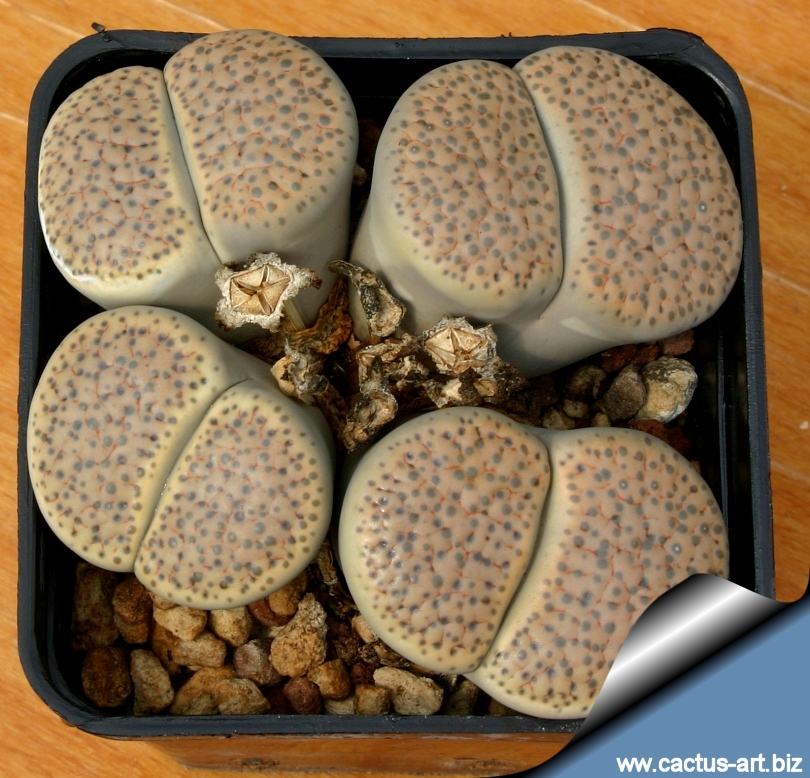
Lithops
fulviceps var. lactinea C222
Grey body and pinkish-milky-grey top with (usually) a few thin red
lines and grey dots.
|
|
Description: L. fulviceps
is generally smaller than most Lithops but its
shape follows the same pattern of a
cordate (heart-shaped),
bifurcate body of two
leaves, cleft nearly to the
base and showing a pattern of channels, islands and
windows on the top face. This species usually do not shows clearly
evident margins,
windows, channels and islands, but the top of the leaves are scattered
by numerous dots ( dusky dots) and are more or less reticulated by
slightly impressed grooves that sometime form a conspicuous network.
The patterns of colour and dots on the face is
more or less regular within certain ranges of similarity. For this
species, the dusky dots are very specific ranging in colour from
dark grey through browns to purple.
Flowers: Yellow, medium sized up to 35 mm wide but usually less.
Fruit: 5 loculed capsules.
Seeds: Yellowish brown to brown; smooth to rugose.
Lithops fulviceps comprises several more or less intergrading and
distinct variety:
-
var. fulviceps (N.E. Brown)
N.E. Brown 1914. Cole numbers: C170, C220, C221, C266,
C278, C284, C390, C391; (*lydiae) C219
It is a
medium sized elliptical plant about 30 X 23 to 40 X 27 mm wide, It
branches easily and forms clumps with up to 10 (or more) heads, but
usually less. It is somewhat variable in colour, usually uniform rusty
yellow-brown to orange-red-brown, but also grey-brown, grey with
greenish or pinkish or purplish tinges, but otherwise very uniform.
Dusky dots are dark grey-green to blue-green. Shoulders often as for
the face but duller.
-
var. lactinea
D.T. Cole 1973. (Syn:
Lithops.
geoffreyi, Lithops verruculosa)
Cole number: C222.
It is endemic to a very small area where it is found growing on a
gentle limestone slope. This plant except for the face colour is the
same as the type. Face is opaque, milky bluish or greenish or pinkish
grey-white or grey with dusky dots mainly bluish green. Shoulders
milky grey-white, or bluish grey-white. Rubrications yellowish or
reddish orange, sometimes barely visible. It is a medium medium to
large plant up to 40 X 30 mm wide. Usually few branched with up to 4
heads (or more in cultivation).
-
var. laevigata
D.T. Cole (2006) Cole number:
C412 This variety is quite
uniform and distinguishable for it more smooth surface, as if
polished. It has small subcutaneous dots, not the large raised dusky
dots which characterize the type variety. The plants are also
distinctly smaller in all dimensions, with rarely visible rubrications.
The face and shoulders colour is always rusty brown, sometime with few
distinguishable islands. The channels (if present) are dark
olive-green and obscurely transluscent.
Cultivars:
-
Lithops fulviceps cv' Aurea'
(Originally published as L. fulviceps f. aurea
by Y. Shimada in 1977). Cole number: C363. The plant
originates in cultivation either in USA and in Japan, it is
yellowish-green to or creamy-blue green in colour with white flower,
but is otherwise the same as var. fulviceps. The usky dots are raised,
dark dull greyish or bluish green. Rubrications (if present) is very
fine pale brownish-orange.
|
|
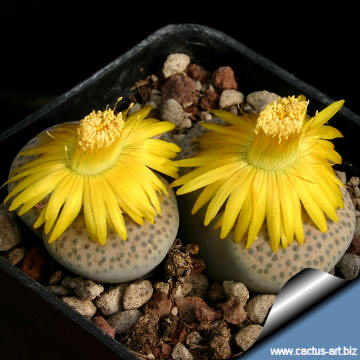
Lithops fulviceps var. lactinea C222 |

Lithops fulviceps var. lactinea C222 |
|
. |
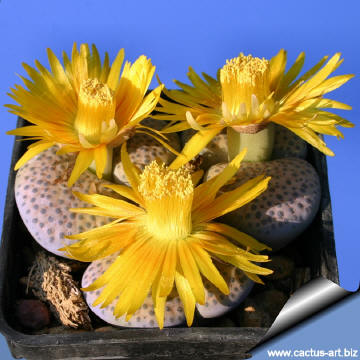
Lithops fulviceps var. lactinea C222 |

Lithops fulviceps var. lactinea C222
Flowers are small to medium
sized yellow , up to 32 mm Ø,
mostly 20-25 mm Ø. |
|
. |

Lithops fulviceps var. lactinea C222 |
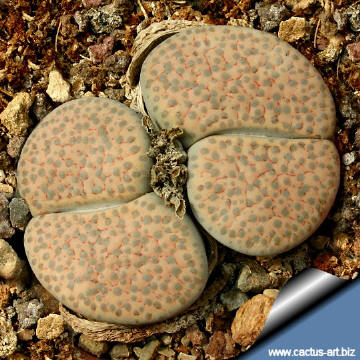
Lithops fulviceps var. lactinea C222 |
|
. |
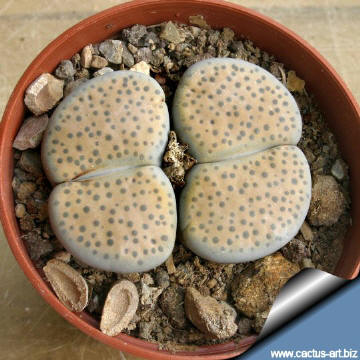
Lithops fulviceps var. lactinea C222 |
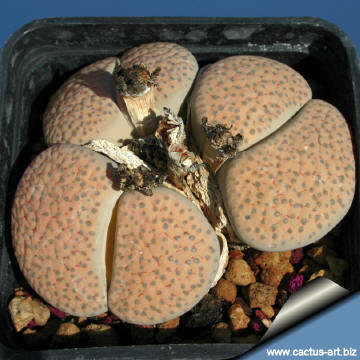
Lithops fulviceps var. lactinea C222 |
|
Advertising
|
|
|
|
Family: Mesebrianthemaceae (Aizoaceae)
Scientific name: Lithops
fulviceps (N.E. Br.) N.E. Br. (1914)
var. lactinea D.T. Cole (1973)
Origin:
TL: 100 km ESE of Keetmanshoop, Namibia
Synonyms:
-
Lithops
geoffreyi
-
Lithops verruculosa
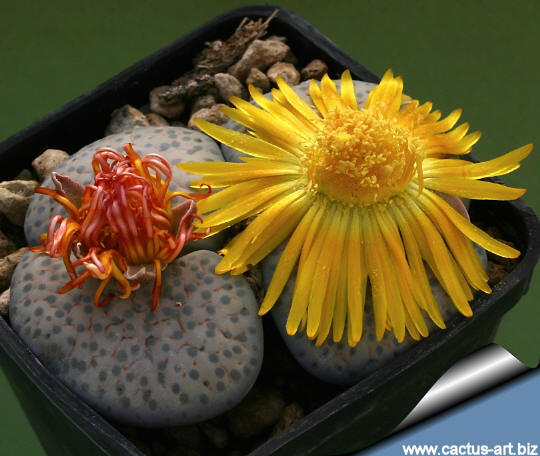
Lithops fulviceps var. lactinea C222
|
|
|
|

Lithops fulviceps var. lactinea C222
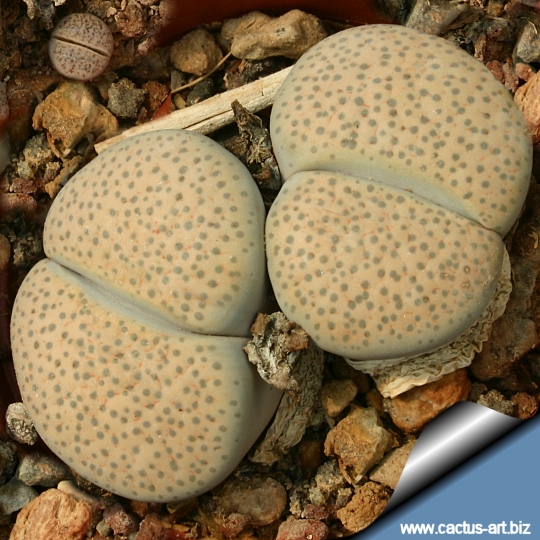
Lithops fulviceps var. lactinea C222
Remarks: Lithops are partly
subterranean, with only the clear 'window'
in each leaf tip exposed above soil. A type of optical system exists
whereby a layer of apical tissue rich in calcium oxalate crystals acts
as a filter to intense sunlight before it reaches the thin
chlorophyllous layer below. They are also called
mimicry plants as they show a striking similarity to their
background rocks and are difficult to detect when not in flower. These
are the commonly known as pebble plants or living stones; each species
is associated with one particular type of rock formation and occurs
nowhere else. Its soil-embedded, subterranean growth form also reduces
the need for chemical defences against herbivores.
Cultivation: Need an open mineral, fast
draining mix and the maximum amount of light you are able to give them.
The basic cultivation routine is: Stop watering after flowering. Start
watering after the old leaves completely dry. (Usually late March or
Early April) Water freely during the growing season, soak the compost
fully but allow it to dry out between waterings,
no water when cold. Some growers fertilize
frequently, some hardly ever. Keep them dry during the winter. Nearly
all problems occur as a result of
overwatering and poor ventilation especially when weather
conditions are dull and cool or very humid. This plant is best for a well lit area (Bright
shade to
full sun). But don't be afraid even
the best growers have plants that mysteriously dry up, or leave during
the night.
Note: After flowering in the
autumn and extending through
winter
season the plant doesn’t need
watering, but they will still be
growing, the new
bodies will be increasing in size extracting
water from the outer
succulent leaves, allowing them to
shrivel away. In fact the plant in this time extracts
water and
nutrient stored in the outer
succulent leaves, allowing them to
dehydrate relocating the water to the rest of the plant and to
the new leaves that form during this period until the old leaves are
reduced to nothing more than "thin papery shells".
Photo of conspecific taxa, varieties, forms and cultivars of
Lithops fulviceps.

 |
|